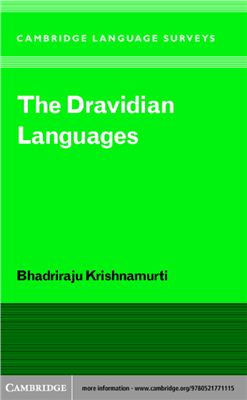Cambridge Language Surveys
Pages: 575
Publisher: Cambridge University Press (2003)
Quality: good: pdf
The Dravidian languages are spoken by over 200 million people in South
Asia and in diaspora communities around the world, and constitute the
world’s fifth largest language family. It consists of about twenty-six languages
in total includingTamil, Malayalam, Kannada and Telugu, aswell as
over twenty non-literary languages. In this book, Bhadriraju Krishnamurti,
one of the most eminent Dravidianists of our time and an Honorary Member
of the Linguistic Society of America, provides a comprehensive study of
the phonological and grammatical structure of the whole Dravidian family
from different aspects. He describes its history and writing system, discusses
its structure and typology, and considers its lexicon. Distant and
more recent contacts between Dravidian and other language groups are
also discussed.
With its comprehensive coverage this book will be welcomed by all
students of Dravidian languages and will be of interest to linguists in
various branches of the discipline as well as Indologists.
ISBN-13 978-0-511-06881-2 eBook (EBL)
ISBN-10 0-511-06881-6 eBook (EBL)
ISBN-13 978-0-521-77111-5 hardback
ISBN-10 0-521-77111-0 hardback
Pages: 575
Publisher: Cambridge University Press (2003)
Quality: good: pdf
The Dravidian languages are spoken by over 200 million people in South
Asia and in diaspora communities around the world, and constitute the
world’s fifth largest language family. It consists of about twenty-six languages
in total includingTamil, Malayalam, Kannada and Telugu, aswell as
over twenty non-literary languages. In this book, Bhadriraju Krishnamurti,
one of the most eminent Dravidianists of our time and an Honorary Member
of the Linguistic Society of America, provides a comprehensive study of
the phonological and grammatical structure of the whole Dravidian family
from different aspects. He describes its history and writing system, discusses
its structure and typology, and considers its lexicon. Distant and
more recent contacts between Dravidian and other language groups are
also discussed.
With its comprehensive coverage this book will be welcomed by all
students of Dravidian languages and will be of interest to linguists in
various branches of the discipline as well as Indologists.
ISBN-13 978-0-511-06881-2 eBook (EBL)
ISBN-10 0-511-06881-6 eBook (EBL)
ISBN-13 978-0-521-77111-5 hardback
ISBN-10 0-521-77111-0 hardback

